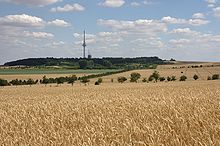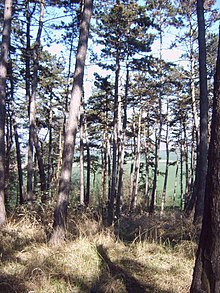Happy mountain
The Frohser Berg is an elevation south of the city of Magdeburg in Saxony-Anhalt .
The elevation owes its name to the town of Frohse , which today belongs to Schönebeck (Elbe) and in whose district the southern part of the hill is located. In the past, the name Frohsesche Berge was also used . In the population, the name Die Kienen was also familiar to refer to the growth of pine trees .
geography
The Frohser Berg reaches a height of 115.5 meters and is part of a range of mountains formed during the Ice Age, which also includes the Kreuzberg mountains to the west and the Sohlen mountains a little further north . There are two towers with radio systems on its summit. The larger tower, the Frohser Berg transmitter , is 158 meters high.
The border between the Westerhüsen district of Magdeburg and the southern town of Schönebeck (Elbe) runs on the hill . The radio towers are just on the Schönebecker district. The western foothills of the Frohser Berg belong to the district of Welsleben .
The Frohser Berg is surrounded by agricultural land. The Frohser Berg landfill is located in the direction of Schönebeck . Due to the location of the Frohser Berg on the edge of the otherwise rather flat Magdeburg Börde , a good view of the surrounding area is possible, especially of the city of Magdeburg. In historical times, a small spring, the legendary Oll-Heinrich-Spring , is said to have been located in a valley basin in the area of the Frohser Berg .
fauna and Flora
After afforestation, the Frohser Berg is made up of a species-rich oak , linden , and pine forest. With its warm, dry forest, bushes and, above all, the dry grass there , the Frohser Berg is a particularly protected biotope . There are a variety of insect species, gray shrike and birds, including the nightingale . Plant species such as the common hazel , the pigeon scabiosa and the field yellow star have been found here. The occurrence of Pontic plants, i.e. plants that actually occur more in the Black Sea area, is also described.
The botanist Paul Ascherson also visited Frohser Berg in the 1850s. In his work on the flora of the province of Brandenburg, the Altmark and the Duchy of Magdeburg , published in 1864 , he listed the plant species that he and his colleagues had found on the Frohser Berg. The flora was varied. Had been found: arable hollow tooth , Anthemis arvensis , Field Nigella , Bromus arvensis , Veronica spicata , Anagallis coerulea , Upright Ziest , Ausdauernder rape yolk , Genista pilosa , mountain Haarstrang , Mountain Clover , Galium glaucum , bristly Vergissmeinnicht , Brown Monkshood , German Enzian , German Cudweed , Hieracium canadense , three teeth , three-toothed orchid , fragrance Skabiose , helictotrichon pratense , Real Wundklee , cowslip , Real centaury , One-year Ziest , Carex humilis , Fine leaved yarrow , rock Stonecrop , rock Yellow star , Festuca myura , Brachypodium pinnatum , Flat bluegrass , Downy meadow oat , spring sedge , Spring Spark , Curved meadow Rue , spotted knapweed , yellow scabious , Reseda lutea , Geneva Günsel , milkwort , serrated lettuce , Carlina vulgaris , prunella grandiflora , chondrilla juncea , Cartilage , Heil-Ziest , Hill-Strawberry , Hill-Clover , Hill-Meie r , alyssum alyssoides , Sparrow tongue , winged Orchid , Small Toadflax , Kleinfrüchtiger camelina , Campanula glomerata , Saxifraga granulata , cabbage and leek , Gypsophila muralis , carrot-shaped adhesive umbel , clove Schmielenhafer , clove broomrape , low Reclining speedwell , Galium boreale , ear spoon campion , Paris bedstraw , bellflower , Linum Catharticum , Purple tragacanth , viola hirta , Rispige's lily , Sand Spurrey , Rotfrüchtiger nightshade , Reddish cinquefoil , Field poppy , Sharp fleabane , Narrow-Wicke , Schopfige finial , Schreberische sedge , Sichelblättriges Hasenohr , silver grass , Marsh knapweed , Cirsium acaule , phleum phleoides , steppe fennel , hair esparto ( Stipa capillata ), bladder campion , Thesium linariaefolium , Nodding dandelion (Thrincie, Leontodon saxatilis ), Violette mullein , white finger herb , Bromus inermis , Meadow goat beard , Meadow pasque flower , Meadow sage , meadow brisket and dwarf feltwort .
Noteworthy is the performance of the Parisian bedstraw, which is now considered extinct in Germany. In July 1866 the presence of ciliated fattening herb was also found.
Transmitter system
On the Frohser Berg, the Deutsche Telekom AG operates the transmitter Frohser Berg, a 158 meter high transmission tower for VHF , DAB , radio relay and mobile radio .
Say
There are several legends about the hill. For example, there is a report of a carter who drove continuously in the Teufelsküche , a ravine near the mountain, probably between Kreuzberg and Krötenberg, without getting anywhere. Another legend tells of the old spring Oll-Heinrich-Spring and how it got its name.
Another legend has come down to us under the name The Treasure in the Devil's Kitchen near Westerhüsen . According to this, Peter Wendeborn , who worked as a farmhand for the Westerhüser Schäfer in the middle of the 17th century, fell in love with the daughter Marie of the wealthy farmer Christian Meylin , who also returned the love. The farmer, however, was against his daughter's marriage to the penniless farmhand. Because of his lovesickness, Peter lost three sheep and their lambs on a summer day. The shepherd sent him out in the evening to look for the animals. After searching in vain in the Wellenbergen and Sohlener Mountains, he finally came to the Teufelsküche on the Frohser Berg in the dark. There too he looked in vain. So he lay down there on the grass to sleep. At midnight he suddenly saw a man with shaggy hair all over his body and a beard that reached down to his stomach. In one hand the man held a large staff that looked like an uprooted fir. The man introduced himself as the treasure keeper in the devil's kitchen and offered Peter to raise a treasure. Peter rejected the spirit as the work of Satan. The treasure keeper looked regretfully and nevertheless began to explain the location of a treasure. If he wanted to dig up the treasure, he had to dig a little further south that looked like a sunken grave. There he would come across a square stone slab. Behind it was a small opening through which he would reach a staircase with 27 steps. At the foot of the stairs there is a spacious hall with three doors. Behind the right door are the bones of the former treasurer, behind the left is the weed chamber where otters and snakes live. He should avoid both doors. Behind the middle door was a great treasure trove of gold and precious stones. He was allowed to take as many gold and silver pieces as he could carry from a copper bowl in the middle. However, a later return to the treasure is impossible. The door to this chamber is tightly locked and can only be opened with a springwort . Any skilled hunter could tell him how to get it. If he goes, he should fill the pit again. The apparition then disappeared.
Peter had to go back to Westerhüsen without sheep, whereupon the shepherd demanded a replacement for the missing animals and threatened to give notice if he hadn't got the sheep back by Johannes. Two days before Johannes, Peter met an old hunter near the country road. They made friends and Peter asked for a spring root. The man advised him to look for the breeding cave of a black woodpecker and to close it with a stick after the woodpecker had gone out. The woodpecker would then look for a spring root itself and thus open the entrance. If you then put a large red cloth under the tree, the woodpecker would be frightened by the supposed fire and let the roots fall. It is important to tie some buckthorn wood to the root every day .
In fact, Peter was released to Johannes. The cost of the sheep was deducted from his wages, so that he went on his way with only two talers. He decided to follow the advice of the treasure guard and the hunter. He took the Westerhüsen ferry across the Elbe to Kreuzhorst . He found a black woodpecker nest in an old, half-dead alder . He proceeded as the hunter had advised him. He borrowed a red cloak from the Schönebeck executioner Master Hämmerling . In fact, the woodpecker came back with a stick in its beak and dropped it at the red cloak. In the evening Peter went with the stick bound in buckthorn wood on the way from Westerhüsen to Welsleben and after about half an hour he came to the devil's kitchen, where he found everything as the treasure guard had said. With the help of the root he was able to open the treasury. He took as much gold and silver as he could carry. He forgot the spring root because of the sheer fear and excitement in the chamber that closed again behind him. As a now wealthy man, he bought a farm in Randau and was ultimately able to marry his beloved Marie.
The legend could, highly speculatively, be interpreted as an indication of a prehistoric burial site that may have originally existed here. The real role model for the legend is assumed to be the Randau sheep master and farmer Peter Bodenburg, who died in 1718.
Individual evidence
- ^ Map of the partial development plan south-east of the Magdeburg city expansion office from 1929, published in Siedlungsentwicklung in Westerhüsen Magdeburg Südost, 1995
- ↑ Friedrich Großhennig, Ortschronik von Westerhüsen in the Magdeburg-SO district , manuscript in the Magdeburg city archive, call number 80 / 1035n, page 3
- ↑ Friedrich Großhennig, Ortschronik von Westerhüsen in the Magdeburg-SO district , manuscript in the Magdeburg city archive, call number 80 / 1035n, page 3
- ^ Paul Ascherson, Flora of the Province of Brandenburg, the Altmark and the Duchy of Magdeburg, Third Department, Special Flora of Magdeburg, published by August von Hirschwald Berlin 1864
- ^ Journal for the total natural sciences , year 1866, 28th volume, Wiegandt and Hempel Berlin 1866, page 184
- ↑ Otto Dieckmann, From the history of Westerhüsens in the General-Anzeiger of September 2, 1923 (here quoted from a copy)
- ↑ W. Schulze, The treasure in the devil's kitchen in Evangelisches Gemeindeblatt Magdeburg-Westerhüsen, between 1924 and 1942
- ↑ Olaf Meister , local sagas from Westerhüsen and the surrounding area , epubli Berlin 2019, ISBN 978-3-748572-28-2 , page 22 ff.
- ↑ Olaf Meister, local legends from Westerhüsen and the surrounding area , epubli Berlin 2019, ISBN 978-3-748572-28-2 , page 37.
- ↑ Olaf Meister, local sagas from Westerhüsen and the surrounding area , epubli Berlin 2019, ISBN 978-3-748572-28-2 , page 40 ff.
Coordinates: 52 ° 2 ′ N , 11 ° 40 ′ E



